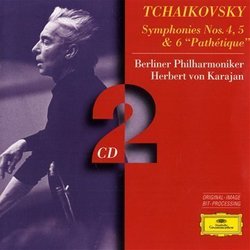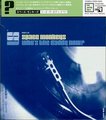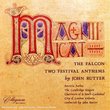| All Artists: Pyotr Il'yich Tchaikovsky, Herbert von Karajan, Berlin Philharmonic Orchestra Title: Tchaikovsky: Symphonies no 4, 5, & 6 / Karajan, Berlin PO Members Wishing: 0 Total Copies: 1 Label: Deutsche Grammophon Release Date: 7/15/1997 Genre: Classical Styles: Historical Periods, Modern, 20th, & 21st Century, Symphonies Number of Discs: 2 SwapaCD Credits: 2 UPC: 028945308821 |
Search - Pyotr Il'yich Tchaikovsky, Herbert von Karajan, Berlin Philharmonic Orchestra :: Tchaikovsky: Symphonies no 4, 5, & 6 / Karajan, Berlin PO
 | Pyotr Il'yich Tchaikovsky, Herbert von Karajan, Berlin Philharmonic Orchestra Tchaikovsky: Symphonies no 4, 5, & 6 / Karajan, Berlin PO Genre: Classical
This moderately priced package gives you the best of Herbert von Karajan's Tchaikovsky performances, and when he was "on" with this composer, he was very impressive indeed. These are exceptionally well played, exciting, ev... more » ![header=[] body=[This CD is available to be requested as disc only.]](/images/attributes/disc.png?v=15401716) ![header=[] body=[This CD is available to be requested with the disc and back insert.]](/images/attributes/disc_back.png?v=15401716) ![header=[] body=[This CD is available to be requested with the disc and front insert.]](/images/attributes/disc_front.png?v=15401716) ![header=[] body=[This CD is available to be requested with the disc, front and back inserts.]](/images/attributes/disc_front_back.png?v=15401716) |
Larger Image |
CD DetailsSynopsis
Amazon.com This moderately priced package gives you the best of Herbert von Karajan's Tchaikovsky performances, and when he was "on" with this composer, he was very impressive indeed. These are exceptionally well played, exciting, even noble versions of the composer's three most popular symphonies, and although Karajan recorded each of them four or five times, this least expensive edition is still the one to get. --David Hurwitz Similar CDsSimilarly Requested CDs
|
CD ReviewsGood interpretations, but Karajan & DG have done better! R. Lane | Tracy, CA USA | 03/14/2004 (4 out of 5 stars) "Herbert von Karajan made fabulous recordings of the last 3 Tchaikovsky symphonies during every decade of his recording career. I believe (but I may be mistaken) there was a recording of the 6th in the series of post-war recordings made by EMI in Vienna. There were some made with the Philharmonia in the fifties also, sadly unavailable. Then, he made the first of 3 sets of all 3 symphonies for DG in the 1960s. He recording the same symphonies for DG in the late 1970s, which are the recordings reviewed here. Then, he recorded them in the 1980s with digital technology. There was another cycle for EMI sprinkled somewhere in between the 3 DG cycles, but those have always seemed tremendously inferior to the 3 DG cycles, and I will not review them here. Interpretively, the set reviewed here is certainly superior, as are all 3 DG cycles. The 4th and 6th have little variation in interpretation, dynamics, or tempi. The 5th is a different story all together. The 1960s 5th is more humane, less obtuse, more deeply felt, whereas the recording of the 5th in this set from the late 1970s seems more distant, almost cold-hearted in comparison. The digital recording lies somewhere in between the other two. The biggest difference between the three sets, though, lies in the sound. And it is with the sound quality that a clear choice exists among the three sets. I rule out the digital set. Im not even sure it is available any longer. The digital set was marred by terrible digital graininess, scratchiness, and what I term "digital twang", which occurs especially with brass, ever so important a section for Tchaikovsky's symphonies. So, the choice comes down to the set reviewed here and the recently reissued 1960s set (Amazon asin # B000001GCR). And I firmly tip my hat toward the 1960s set. The set being reviewed here comes from the late 1970s, when DG had a habit of using as many microphones as humanly possible. I sometimes wonder if they placed a seperate microphone in front of every instrument in the orchestra. It certainly sounds that way sometimes, with very close highlighting of individual instruments or sections. Listen to the 1960s set, though, and you'll hear a difference in the sound that will bring the music to life. I'm reminded of tourists visting the Golden Gate Bridge in San Francisco, only to find it shrouded in fog. It still looks magnificent to them, but because of their short visit, they never get to see it without the fog. Some, however, get to go back when the fog has lifted, and then they are truly in awe of the structure. An appropriate analogy I think, given that Karajan is always described as a great architect in his intertretations. And when you listen to the 1960s recordings after hearing the 1970s recordings, the shroud is truly lifted, and only then can you fully realize that you are in the presence of true greatness. So, go get the 1960s set if you want to hear Karajan work his magic in these works. And the digital remastering of the 1960s set is superior to any of the others too. Cleaned of all eveidnce of tape hiss, restored to perfection. An excellent example of current digital restoration techniques.Those 1960s recordings are also available in a Collector's Series box of 8 disks (Amazon asin # B00004SA8B) that also has some other Karajan Tchaikovsky gems, like the Rococo variations with Rostropovich, a decent Serenade for Strings, the Piano concerto with S. Richter, a very good Romeo and Juliet, the ballet suites, and more." You can't find a better combination M. H. Bayliss | 11/07/2000 (5 out of 5 stars) "For the price of one CD, you get over 2 hours of music on two CD's which happen to feature von Karajan's best performances of these great symphonies. I'm going through a romantic phase right now in my classical listening, so I'm into Tchaikovsky. All three of these symphonies are just tremendous -- loud and boisterous one minute and then sublime the next. The Penguin guide to classical music said that these were simply THE best recordings that Karajan did of these symphonies and after listening a few times, I believe it. The sound quality is not muddy, but it would be nice to have this exact recording with more perfect sound. Still, this is a minor bone to pick on this outstanding collection that manages to find great recordings of these 3 symphonies and gather them into one conveniently priced package. A great deal and many hours of listening pleasure." Karajan Discovers His Genius - Finally M. H. Bayliss | 01/25/2000 (5 out of 5 stars) "Simply amazing. During the same time Karajan was desecrating the Mozart symphonies on DG in the mid 70s, he was recording these beautiful Tchaikovsky performances. I always thought Karajan to be overrated in the bread and butter Beethoven/Brahms symphonies, which he beat into the ground until they were dead and buried, and seemed much more at home in orchestral showpieces by Ricard Strauss, Debussy, or Mussorgsky. But could he find a symphonic medium that fully realized his and the Berlin Philharmonic's talents? These recordings answer that question: the playing is passionate and red-blooded, and Karajan actually seems to be fully involved in the music, as opposed to riding on auto-pilot. There are other wonderful performances scattered around, but here you get all three late symphonies, gloriously played and recorded for the price of a single premium cd. Such a deal."
|

 Track Listings (6) - Disc #1
Track Listings (6) - Disc #1












